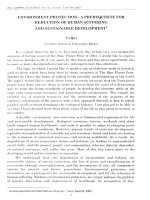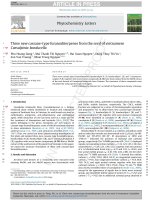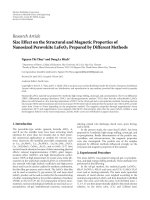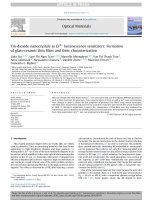DSpace at VNU: Dealing with a positive result: routine HIV testing of pregnant women in Vietnam
Bạn đang xem bản rút gọn của tài liệu. Xem và tải ngay bản đầy đủ của tài liệu tại đây (94.92 KB, 6 trang )
AIDS Care
Vol. 20, No. 6, July 2008, 654Á659
Dealing with a positive result: routine HIV testing of pregnant women in Vietnam
P. Oosterhoffa*, A.P. Hardonb, T.A. Nguyenc, N.Y. Phamd, and P. Wrighte
a
Medical Committee Netherlands Vietnam, Hanoi, Vietnam; bUniversity of Amsterdam, Amserdam School for Social Science
Research, Amsterdam, Netherlands; cHanoi Medical University, Hanoi, Vietnam; dDepartment of Sociology Hanoi National
University, Hanoi, Vietnam; eVietnam eMedical Committee Netherlands Vietnam, Hanoi, Vietnam
(Received 2 April 2007; final version received 10 September 2007)
HIV testing is an essential component of PMTCT. It can be offered to pregnant women through different testing
models, ranging from voluntary counseling and testing (VCT) to routine and mandatory testing. This study was
conducted in Hanoi, Vietnam, where HIV-prevalence is low among the general population, but high among
young, urban, sexually active, male intravenous drug users. Women who want to deliver in a state hospital are
routinely tested for HIV in the absence of well-defined opt-out procedures. In-depth interviews with a
convenience sample of 38 seropositive pregnant women and mothers and 53 health workers explored the
acceptability of routine testing. Patients and healthcare workers appeared to accept routine ‘blood’ tests
(including HIV tests) because they feel uncomfortable discussing issues specific to HIV/AIDS. To avoid having to
inform women directly about their HIV status, health workers at routine testing sites rely on the official
notification system, shifting the responsibility from the hospitals to district and commune health staff. The
notification system in Hanoi informs these local officials about the HIV status of people living in their catchment
area without patients’ consent. Our study shows that this non-confidential process can have serious social,
economic and health consequences for the HIV-positive women and their children.
Keywords: Vietnam; routine testing; VCT; PMTCT; stigma
Introduction
Prevention of mother to child transmission (PMTCT)
is a strategically important intervention to slow the
spread of HIV/AIDS. In Vietnam the national
prevalence of HIV was estimated at 0.5% in 2005.
The epidemic is concentrated among young male
intravenous drug users (Ministry of Health, Vietnam
[MOH], 2006b), 50% of them between the ages of 20Á
29 (Nguyen, 2007).
This study was conducted in Hanoi, in the North
of Vietnam, where rapid economic growth and easily
available heroin are associated with increased intravenous drug use. HIV-prevalence among male intravenous drug users is 20Á70% (Hien et al., 2001;
Hien, Giang, Binh, & Wolffers, 2000; MOH, 2006a,
Tung et al., 2001) with a rate among female
commercial sex workers of 6.5% in 2005 (Socialist
Republic of Vietnam, 2005; Tran, Detels, Long, &
Lan, 2005). The prevalence rate among pregnant
women increased from 0.02% in 1994 to 0.37% in
2005 (MOH, 2006a; MOH & Department of Health
Legislation, 2006) and is as high as 1.25% in Hanoi.
Women found to be HIV-positive often face stigmatization as a possible sex-worker or drug user (Khuat,
Nguyen, & Ogden, 2004).
*Corresponding author. Email:
ISSN 0954-0121 print/ISSN 1360-0451 online
# 2008 Taylor & Francis
DOI: 10.1080/09540120701687026
In Vietnam, pregnant women can be tested at
ante-natal care (ANC) facilities or at voluntary
counseling and testing (VCT) sites (by 2006 there
were around 50 VCT sites in the country [National
Committee for AIDS, Drugs, Prostitution Control &
Health, 2006]). The new HIV/AIDS law (January,
2007) legalizes a system of voluntary, routine and
compulsory HIV testing (the latter in circumstances
as yet undefined [Socialist Republic of Vietnam,
2006]). Government health facilities have held responsibility for HIV testing among people at risk
since 1995 (AIDS Ordinance, 1995).
The World Health Organization (WHO) and the
US Centers for Disease Control and Prevention
(CDC) promote routine testing for HIV now that
accessibility to anti-retroviral medication is increasing. They recommend that such routine testing should
be accompanied with a clear ‘opt-out’ procedure
(CDC, 2006; WHO/UNAIDS, 2007). As HIV
programs scale up, documentation is needed on
how opt-out and VCT models work in practice.
This qualitative study examines how (pregnant)
women, their families and health providers experienced VCT, routine HIV testing, disclosure and
notification in the Hanoi health system. This setting
AIDS Care
could be described as low HIV-prevalence with high
ANC coverage.
Currently, HIV tests are routinely offered to
pregnant women in hospital before delivery and
through ANC services in district health centers. In
ANC sites, HIV tests are one of a set of tests
conducted Á others include blood count, blood type,
blood sugar, hepatitis B and syphilis. These test are
done when women are 7Á8 months pregnant. When
an HIV test is positive, health workers at district or
commune are asked to inform the HIV-positive
women in their homes. But despite such routine
testing in ANC sites and delivery services, few women
seem to be detected by this system: In 2005, just 659
pregnant women were reported to be HIV-positive in
the whole country, while the number expected from
surveillance data was 7,000Á8,000. (National Committee for AIDS, Drugs, Prostitution Control &
MOH, 2006; Socialist Republic of Vietnam, 2005).
One reason for such under-reporting may be that
HIV testing is not available at commune health
centers. Women who use the commune health center
for both ANC and delivery will not be tested.
Methods
Respondents
We used semi-structured question guides to interview
a convenience sample of 38 sero-positive women in
Hanoi. Thirty-six women had recently delivered.
Because HIV prevalence is low, and interviewing
women just before or after receiving a positive result
is practically and ethically difficult, the women were
recruited from support groups and from national and
provincial obstetric hospitals. Pregnant women identified as HIV-positive at government facilities in
Hanoi are increasingly referred to support groups,
where they receive medical, social and economic
support. The first interviews took place at the support
group office outside the hospital after the women had
signed consent forms. HIV-positive pregnant women
who terminate their pregnancy may be more likely to
keep their status secret and less likely to join support
groups, consequently they are under-represented in
our sample. The sample included two women who
had had an abortion after receiving a positive test
result at a VCT center. All the other respondents were
young mothers who had delivered within the last 30
months.
The topics covered in our interviews were: experience with and views on ANC, VCT, routine opt-out
and mandatory HIV tests; counseling; disclosure;
social-economic support; care; and health. Partners
or a relative of 33 of the women were interviewed
655
separately. The other women did not have partners or
family members willing to be interviewed.
The women and their partners came from a
variety of social and economic backgrounds. Most
(32/38) were 20Á30 years old; five women were 30Á35
and one was over 40. Only two had a reported history
of sex work and injecting drug use. In contrast, all of
the partners had a reported history of intravenous
drug use, visits to sex workers or both. Six of the
women were AIDS widows. Four women had been to
university and all but two had completed a high
school education.
Our respondents had learned about their HIVpositive status in the following ways: through the
notification systems, after testing in ANC (18 women); at a VCT center attended after husband or
child was found to be HIV-positive (19 women); and
through mandatory testing at rehabilitation center
(1 woman).
We also conducted semi-structured interviews
with 53 healthcare workers on the quality and
quantity of PMTCT services in Hanoi, using a
multi-stage sampling frame. Health workers at all
national and provincial hospitals in Hanoi providing
PMTCT or anti-retroviral therapy (ART) at the time
of our study (2005/6) were selected; all provide VCT
and routine HIV testing before deliveries. The sites
included were the National Obstetric Hospital, Hanoi
Obstetric Hospital, Bachmai Hospital, Dongda Hospital and the National Pediatric Hospital. At these
hospitals, we visited the VCT facilities and ANC
departments and interviewed the department heads
and at least one other health worker.
To interview health workers at the district and
commune level of healthcare, we selected the district
with the highest HIV prevalence in the city, Dongda,
where we interviewed health workers in all district
health facilities that provide HIV testing, ANC or
maternity services. We selected four communes (out
of a total of 21) with the highest HIV prevalence and
interviewed the heads of the commune health centers.
At this level, the heads also treat patients but testing
is not done. Inclusion criterion for interviewing the
health workers at all levels was that they had been
working at the facility for at least one year.
Acceptability of offering routine and mandatory tests
for pregnant women
Eighteen of the women learned they were HIVpositive after routine testing at ANC facilities, which
is usually done at 7Á8 months of pregnancy. The
pregnant women perceived the offering of routine
HIV tests during ANC as reasonable. Frequently
heard comments from women and their families
656
P. Oosterhoff et al.
included: ‘‘HIV tests are just like other tests’’, ‘‘They
need to know that to help me’’ and ‘‘Doctors need to
be able to protect themselves during their work’’.
The interviewed women saw no differences in
principle between an HIV test and other medical
tests, like that for hepatitis B.
We found that when women come to a hospital
for delivery they are routine tested for HIV and not
told that they can refuse: testing is mandatory. The
only hospital that does have an opt-out procedure for
women who come for delivery is the National
Obstetric Hospital. Many women explicitly stated
that mandatory testing prior to delivery is acceptable
because of the association of HIV with socially
stigmatizing behavior. They argued that women do
not want to have to ask for an HIV test because that
might suggest that they had socially unacceptable
behavior. They said: ‘‘HIV tests should just be more
normal’’, ‘‘All women should be tested, not just a few
based on their or their husbands’ appearance [as a
drug user]’’, ‘‘I would be afraid to ask for an HIV
test, because the doctors might think something’’.
All 38 women stressed the importance of HIV
testing during pregnancy for having healthy children
but the thought that the timing of the tests was too
late in the pregnancy: ‘‘I would not have had a child if
I had known that I was positive’’, ‘‘I would not have
taken that risk myself’’.
A few of them commented that if the tests were
voluntary, some patients might decline them to save
money (a user-fee has to be paid for the tests).
Acceptability of routine and mandatory tests to
health staff
The health workers interviewed were unanimously in
favor of routine HIV testing. They stressed the
importance of testing for PMTCT thus: ‘‘It is easier
for us to prevent transmission if we know who among
the patients is infected with HIV’’ and ‘‘We need to
know who is infected with HIV in order to help them
get treatment’’.
Only a few healthcare workers mentioned that
patients needed counseling. They did not see counseling as a way to enable women to decide for
themselves whether or not they wanted a test. As
one health worker said: ‘‘Women should know what
is included in an ANC check up, and how many tests
they will have and why.’’
Health workers at district level and below liked
routine testing at seven-months’ gestation because it
protects them from having to deliver babies in HIVpositive women who are referred to provincial and
national hospitals. Without prompting, staff expressed greater worries about hepatitis B than HIV,
because hepatitis B is more contagious and because
they cannot refer pregnant women with hepatitis B to
national and provincial hospitals.
Health workers at all levels also pointed out the
normalizing effect of routine testing (as a standard set
of blood tests) in an environment where HIV is
socially stigmatized: ‘‘I am afraid to offer people HIV
tests because they might get angry at me and think I
am judging them’’.
Some health workers mentioned that in ‘‘suspicious’’ cases they would not want to wait for the
routine tests late in pregnancy, due to concern over
their own and the woman’s health. Reasons for
suspicion were: looking like a drug user, being
accompanied by somebody who looked like a drug
user, having certain jobs, such as ‘hotel work’, being
married to ‘drivers’, simply ‘looking bad’ or medical
symptoms such as opportunistic infections or very
low weight.
Six health workers in one hospital and two in the
ANC clinic mentioned that they had conducted blood
tests on patients without informing them: ‘‘We only
tell them we’re taking a blood test, because if we say
‘HIV test’ they refuse to take the test’’.
All health staff argued in favor of offering HIV
testing for free. They mentioned technical and
economic restrictions to offering HIV testing earlier
in the pregnancy: ‘‘The results could change during
the pregnancy, which could be dangerous for the
woman’s health at the time of delivery. If we do
separate or repeat tests early and late in pregnancy it
is very expensive’’.
Acceptability of VCT
The 19 women who went to VCT centers after their
husband or child became sick considered VCT a very
important service for people who want to know their
status. Three of these women went for VCT early in
pregnancy, while two opted for abortion when the
test was positive. All 18 women who had initially
found out they were HIV-positive through routine
testing subsequently also visited a free VCT site in
order to confirm the result: ‘‘I just could not believe
that I was positive. I went three times. After I kept
getting the same result I had to believe it’’, ‘‘I know
that my child must have received the virus from me.
But I went for testing to be sure and to learn more
about the disease’’.
All the health workers considered VCT primarily
an intervention targeting drug users and sex workers.
They stress that VCT cannot replace routine testing
during ANC.
AIDS Care
Two parallel systems of counselling: counselling in the
hospital and through notification
Pregnant women tested at VCT centers and national
sites receive their results there. Those who are tested
during ANC at provincial or district level are not
only supposed to be informed about their test results
in the facilities; they also receive their test results at
home through the ‘notification’ system. All commune
and district government health facilities in Hanoi
have to notify the provincial authorities of suspected
HIV-positive cases. After confirmation, the provincial authorities inform the local health workers at the
district and commune levels, who then inform the
patient and her/his family.
Fourteen of the 18 women who were tested at an
ANC site received their results from a health worker
through the notification system in their community
(see Table 1). In all cases of mandatory testing prior
to delivery, women reported that one or several
visiting family members were informed while the
woman was still in hospital, without the woman’s
consent. Five women were, in fact, not informed
about their status at all at this stage. Three of them
said that they understood the staff’s decision not to
disclose the HIV-positive result to them. They
emphasized that both their families and the health
staff probably ‘‘wanted to protect’’ them. Two of
these non-informed women objected. One was told at
the delivery table that she was HIV-positive:
‘‘They gave my husband counseling but he did not
tell me because he was afraid that I was too weak at
that time. That’s why I breastfed my son until my
husband told me the truth after two months.’’
Her son died of AIDS.
Family members reported that they did not feel
prepared to inform their daughters-in-law. One said,
‘‘I just could not bring myself to tell my sister in law
that she was positive. Her husband had just died.’’
Healthcare workers at routine testing sites did not
have to use the community notification system to
inform their clients of their status, but found it
difficult to inform and counsel patients about a
positive HIV test result. They gave various reasons
657
for avoiding informing women directly about their
status. Some mentioned ‘‘the weak health’’ of the
women. Being ‘‘too busy’’ to inform all patients
because ‘‘staff has to focus on the delivery’’ was
mentioned several times by both patients and health
staff as a reason for staff not informing the patient.
District and commune health workers stressed the
public health benefits of the community notification
system for both the community and the individual.
But, women complained about breaches of confidentiality when the commune health workers come to
inform them about their status and counsel them in
their homes:
‘‘Whenever they visited my home, they still wore their
white coats; that is unusual so it attracted attention
from neighbors which is not good. I prefer to visit the
clinics myself and only when somebody is really
sick.’’
They also complain that the quality of counseling is
poor. One woman was told not to eat at local food
stalls and not to have her hair washed at a local salon
and she was warned by health staff not to sell food or
drinks. Another woman was told to use formula
feeding for her infant, which she could not afford.
Several interviewees described adverse mental
health effects from the public disclosure of their
HIV status: ‘‘I just lay in bed for three months after
they came to the door’’, ‘‘My husband became
depressed and escaped into drugs.’’
After notification by a commune healthcare
worker, many young mothers said, that people
treated them and their husbands and children in a
different way. Almost all families introduced some
segregation for both husband and wife after notification. For example, they and their partners could no
longer eat at the same table, share dishes or share the
toilet; a few were thrown out of the house. Several
women described feeling insecure about their own or
their children’s future in the household:
‘‘My mother-in-law likes my sister-in-law’s baby
more than my son. When the two children play
together, she always wants to separate my son. She
Table 1. Modes of testing and counseling (n 037 HIV-positive women).
Number of women who received counseling at a
health facility about their test results
Number of women informed about
their HIV status in their homes
Testing site
Yes
No
Yes
No
VCT
ANC
19
13
0
5
1
14
18
4
*One interviewee was not included in this table because she was first tested and counselled in a rehabilitation camp.
658
P. Oosterhoff et al.
beats my son. She already told us that when we die
our son has to go to an orphanage.’’
Others described losing jobs after notification. A
hairdresser who worked at the market was unemployed because:
‘‘Somebody who works in the market saw the health
workers at my in-laws’ house to counsel my in-laws
while I was at the market. My husband died and my
in-laws do not pay for my food but I cannot work in
the market anymore because now everybody knows.’’
Some of our respondents said they tried to avoid
notification by giving the wrong address at the ANC
site. One couple, of which the woman had tested
positive during ANC at the provincial level, moved
house immediately after they found out from the
support group members about the notification procedure and the associated lack of confidentiality.
Discussion
The women in this study comprise two groups Á
women who see themselves at risk and go for VCT
where their test results are treated confidentially and
women who are not aware of their risk, are detected
at ANC sites and are notified in their community.
Our findings suggest that both healthcare workers
and patients agree on the medical importance of
offering the tests as a provider-initiated routine
procedure in health facilities. They appreciate the
fact that this approach allows them to avoid having
to discuss testing for a stigmatizing disease. However,
the HIV-positive women who are informed about
their test results by commune health workers through
the community notification system report that they
feel stigmatized because their privacy is not respected.
Worldwide, increased access to anti-retroviral
medications has led to policies that promote routine
provider-initiated testing with opt-out procedures
(Bayer & Fairchild, 2006; CDC, 2006; Jayaraman,
et al., 2003; Simpson, Johnstone, Goldberg,
Gormley, & Hart, 1999; Walmsley, 2003; Weiser
et al., 2006; WHO/UNAIDS, 2007). The introduction
of rapid tests enables this trend: health systems no
longer need complex confirmation procedures that
act as barriers to counseling and lead to delays in
notification and loss to follow-up (Branson, 2003).
HIV prevalence is relatively low in Vietnam; the
average pregnant woman has a low risk of testing
HIV-positive but our findings suggest that a positive result can have very serious social and health
consequences. The quality of post-test counseling in
the hospitals and district levels of healthcare is
currently not good enough. Post-test counseling
can, moreover, only be conducted when the results
of the HIV tests are confirmed. Rapid tests are not
yet used in Hanoi. When positive results are received
from the confirmation centers, health workers are
uncomfortable about informing women. This reflects
not only their lack of communication skills and
technical knowledge, but also the cultural values of
saving face and showing care by protecting people
from bad news. Technical knowledge may be improved quickly by training, and the introduction of
rapid tests can facilitate the process, but these
powerful cultural norms are unlikely to change
rapidly. Programs that train health workers in the
various PMTCT options, make them more sensitive
to the reproductive rights of women and improve
their counseling skills are urgently needed. Such
programs need to be sensitive to the Vietnamese
cultural tendency to avoid talking about a stigmatizing disease but should also provide acceptable
approaches for informing women of their HIVpositive status.
HIV-positive women were found to often go for
repeat tests to confirm their status and receive
additional counseling. A combined system of routine
testing in ANC with appropriate post-test counseling
and opt-out and confidentiality procedures, along
with good quality and accessible VCT is needed to
meet this demand and increase uptake of testing in
pregnancy. The health authorities in Vietnam also
need to consider expanding the routine testing in
ANC to the commune level of healthcare, using
simple rapid test kits Á this would remove the need
to inform HIV-positive women of their status in their
homes and thereby significantly reduce the stigma
that they face. Pregnant women who are at risk (for
example partners of intravenous drugs users) need to
have access HIV tests early in pregnancy, when
abortion is still possible. The health system should
enable such early testing and ensure that these women
at risk get the counseling they need to make their own
reproductive choices.
References
Bayer, R., & Fairchild, A.L. (2006). Changing the paradigm
for HIV testing: The end of exceptionalism. New
England Journal of Medicine, 355, 647Á649.
Branson, B.M. (2003). Point-of-care rapid tests for HIV
antibodies. Laboratoriumsmedizin, 27, 288Á295.
CDC (2006). Revised recommendations for HIV testing of
adults, adolescents and pregnant women in health-care
settings. Centres for Disease Control and Prevention.
Atlanta, September 2006. />preview/mmwrhtml/rr5514a1.htm
AIDS Care
Hien, N.T., Giang, L.T., Binh, P.N., Deville´, W., van
Ameijden, E.J.C., & Wolffers, I. (2001). Risk factors of
HIV infection and needle sharing among injecting drug
users in Ho Chi Minh city, Vietnam. Journal of
Substance Abuse, 13, 45Á58.
Hien, N.T., Giang, L.T., Binh, P.N., & Wolffers, I. (2000).
The social context of HIV risk behavior by drug
injectors in Ho Chi Minh city, Vietnam. AIDS Care,
12, 483Á495.
Jayaraman, G., Preiksaitis, J.K., & Larke, B. (2003).
Mandatory reporting of HIV infection and opt-out
prenatal screening for HIV infection: effect on testing
rates. Canadian Medical Association Journal, 168, 679Á
682.
Khuat, T.H., Nguyen, T.V.A., & Ogden, J. (2004). Understanding HIV and AIDS-related stigma and discrimination. Washington DC, USA: International Center for
Research on Women.
Ministry of Health, Vietnam (2006a). Decision 214/2006/
QD-TTg. Approval for the proposal ‘‘Manage vocational training and job advocacy for ex drug users in
Hanoi’’. Hanoi: MOH.
Ministry of Health, Vietnam (2006b). Five-year review
workshop on HIV/AIDS prevention and control in
2001Á2005 and action plan for 2006Á2010. Hanoi:
MOH.
Ministry of Health & Department of Health Legislation,
Vietnam (2006). Law on HIV/AIDS Prevention and
Control. Hanoi: MOH.
National Committee for AIDS, Drug and Prostitution
Control & Ministry of Health (2006). Five-year review
workshop on HIV/AIDS prevention and control in 2001Á
2005 and action plan for 2006Á2010. In: 149/BC-BYT.
Hanoi: MOH.
659
Nguyen, T.H. (2007). Situation of HIV/AIDS/STI surveillance in Vietnam. Paper presented at the National
Conference on HIV/AIDS Monitoring and Evaluation, Hanoi.
Simpson, W.M., Johnstone, F.D., Goldberg, D.J., Gormley, S.M., & Hart, G.J. (1999). Antenatal HIV testing:
Assessment of a routine voluntary approach. British
Medical Journal, 318, 1660Á1661.
Socialist Republic of Vietnam. (1995). Ordinance on the
prevention and control of HIV/AIDS. Hanoi: National
Assembly’s Standing Committee.
Socialist Republic of Vietnam (2005). Second country report
on following-up the implementation to the Declaration of
Commitment on HIV/AIDS January 2003ÁDecember
2005. Hanoi: MOH.
Socialist Republic of Vietnam. (2006). Law on HIV/AIDS
prevention and control. Hanoi: MOH.
Tran, T.N., Detels, R., Long, H.T., & Lan, H.P. (2005).
Drug use among female sex workers in Hanoi,
Vietnam. Addiction, 100, 619Á625.
Tung, N.D., Tuan, N.A., Hien, N.T., Hoang, T.V., Thang,
B.D., Chung, A.K.T., et al. (2001). Behavioural survey
in Vietnam 2000. National AIDS Standing Bureau,
Hanoi: NASB, Family Health International.
Walmsley, S. (2003). Opt in or opt out: What is optimal for
prenatal screening for HIV infection? Canadian Medical Association Journal, 168, 707Á708.
Weiser, S.D., Heisler, M., Leiter, K., Percy-de Korte, F.,
Tlou, S. et al. (2006). Routine HIV testing in Botswana: A population-based study on attitudes, practices
and human rights concerns. PLoS Medicine, 3, e261.
WHO/UNAIDS (2007). Guidance on provider-initiated HIV
testing and counselling in health facilities. Geneva:
WHO.









